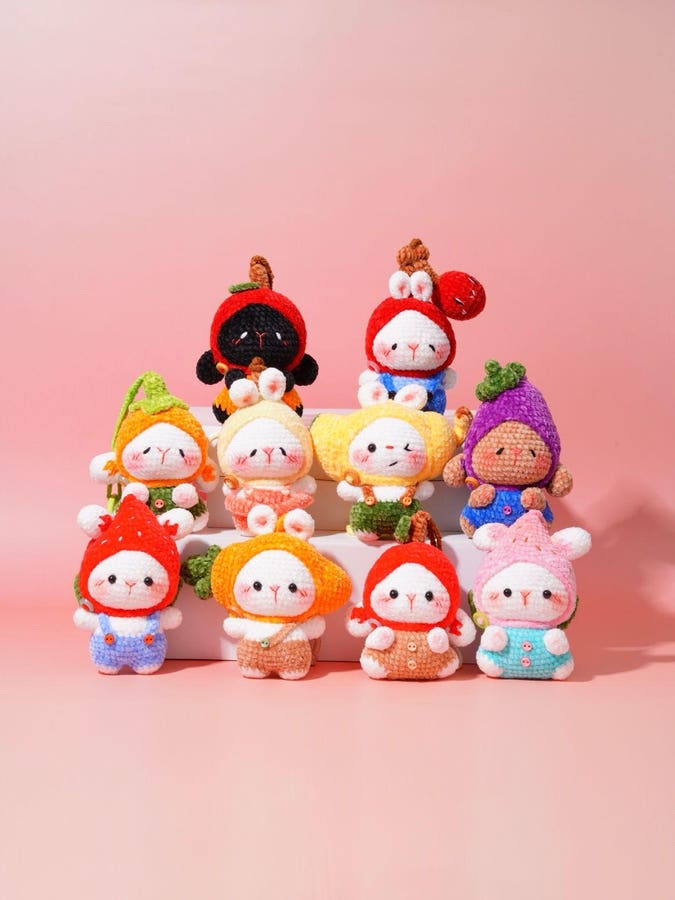The Fruity Bunnies from Happy Vanilla
Courtesy Happy Vanilla
When the Hong Kong-born artist Kasing Lung sat down to design, who knew that his furry monster with cute ears, fangs, and a wide, menacing smile would go on to change popular culture? It was a gamble — but one that was to pay off amid the growing trend of adults collecting toys. From Star Wars to Warhammer, such things have never been the sole preserve of children. What’s changed is the money.
In October, luxury brand Moynant debuted a capsule collaboration with Lung, the creator of the Labubu toy, in Shanghai, indicating the bankability of the phenomenon at even the highest levels. Not since Ty Warner dropped his $5 Beanie Babies in the 1990s has there been such a surge of hysteria. Chinese company Popmart, the Labubu toymaker, said its global revenue for the three months to the end of September jumped by about 250% compared to a year earlier. International sales helped drive the increase, with revenue in America up by more than 1,200% as fans around the world hoover up its selection of boxed toys.
Social media has played its part, with plushies, dolls, and cuddly toys going viral—against a backdrop of creators celebrating everything from classic playsets to surrealist soap comedy (Sylvanian Drama, we’re looking at you). Alongside Popmart offerings, Jellycat plushies, LEGO sets, and anime figurines are all gaining in popularity. Has the global consumer found its inner child?
Moynat unveiled an exclusive collaboration with artist Kasing Lung, creator of The Monsters, in September
Courtesy Monyat
Harrods head of toys buying Kate Woodhead told Vogue Business earlier this year that there has been an undeniable increase in “kidult” customers in recent years, with what seems like “a real appetite for nostalgia, joy and perhaps a simpler time.” She points out that this has even spilled out to affect culture more generally: “Consider the effect of movies like Barbie or Minecraft—all born from toy trends that are appealing to a much broader adult market.”
One of these, Happy Vanilla, is a crochet toy brand with the tagline for the kid inside your heart. What began as a pandemic hobby for Yina Wan (a former banker with a background in textile engineering) in a quiet Southwestern suburb of London is the next brand looking to tap the kidulthood goldmine.
“Adults want something comforting and playful—something that connects to their inner child,” says Wan who started crocheting as a way to stay grounded during the COVID-19 lockdowns. CEO Jun Guo took notice once she started selling her creations at a local artisan market and discovered she had built up a following. He soon realised there was a business behind Wan’s whimsical creatures. Now there’s a full team at Happy Vanilla which believes its model—community-powered and detail-obsessed—could replicate the success of giants like China’s Popmart and the UK’s Jellycat. Or at least partially anyway.
“These aren’t just cute items, they’re like miniature artworks made by artisans with exceptional skill,” explains Guo, who thinks Happy Vanilla’s unique appeal lies in the fastidiousness and deep craftsmanship of its crochet army.
Wan is quick to continue: “And what makes us different is that our toys aren’t made in factories. They’re made by people, for people.” The production team is largely composed of women based outside of major cities across rural China—many of whom are full-time homemakers supplementing their income.
“We pay above minimum wage, and because we’re makers ourselves, we’ve earned their trust. It’s a tight-knit community—pun intended.” Their knowhow is highly specialized meaning the brand can claim a genuine sense of ethical craft.
Yina Wan, founder of crochet brand Happy Vanilla
Courtesy Happy Vanilla
This downside of this offering is its scalability. Crochet isn’t easily mechanized, and Guo admits there aren’t many machines that can replicate what artisans do. Happy Vanilla is looking at ways to expand such as by standardizing base components, with each item still “finished by hand” for that unique touch. “In some ways, it’s like ceramics in the 18th century. It started out as artisanal. Then it scaled. Crochet may be next,” he continues.
Retaining the community aspect, whether that’s technical makers or consumer-led, is vital to Wan’s vision. Plans are already underway to launch a flagship store (in 2026) that doubles as a fan space, creative hub, and gallery for micro-crochet artworks. The model includes co-creation with customers, from workshops to custom orders. The founder frequently hosts sessions—from local neighborhoods to care homes—helping others learn to crochet and maintain fine motor skills. “It’s therapeutic,” she says. “Our customers help us design. We build together.”
Fashion, too, could be an obvious next step especially given the long list of collaboration potential proven by Popmart. Happy Vanilla has plans to venture into accessories such as micro-crochet earrings, brooches, and themed bags. “Brands like Louis Vuitton have launched crochet-inspired accessories. It’s a growing trend in shows over the last number of years,” Guo explains. “We believe there’s space for collaborations that highlight craftsmanship and storytelling.”
Jarno Leppänen, co-founder of the fashion brand Ka Way Key, which featured delicately crocheted flowers in its Spring Summer 26 runway show in Hong Kong, agreed on the potential for the trend on and off the runway. According to Leppänen, each crocheted piece carries its maker’s personal touch—and therefore crochet reflects individuality and craftmanship, something that mass production cannot replicate. “Crochet shows that it is possible to combine the past and the future, even under the eyes of very critical (fashion) audiences and consumers.”
The Pancake Cat crochet collection from Happy Vanilla founded by Yina Wan
Courtesy Happy Vanilla
MORE ON FORBES


